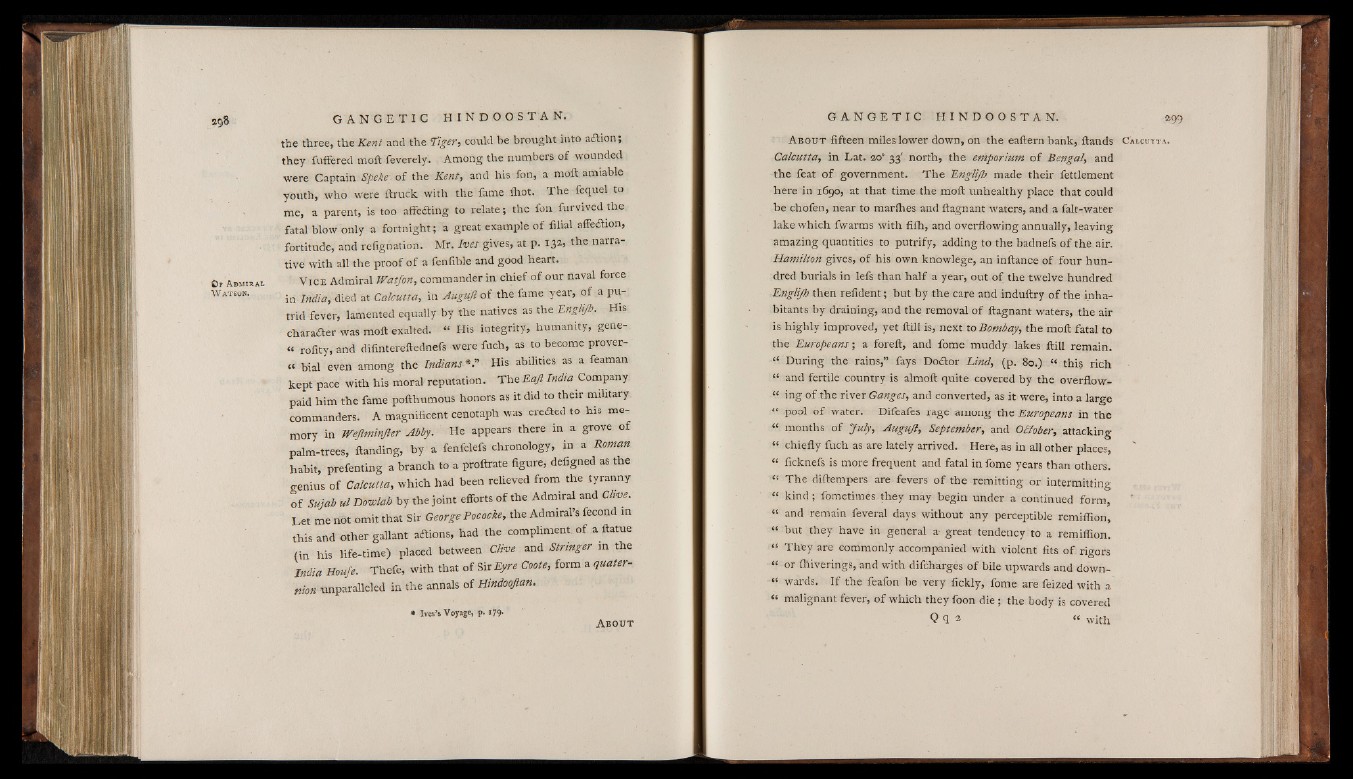
the three, the Kent and the Tiger, could be brought into a£tion;
they fuffered moft feverely. Among the numbers of wounded
were Captain Speke- of the Kent, and his. fon, a moft amiable
youth, who were {truck with the fame ihot. The fequel to
me, a parent, is too aiicc'ting to relate; the fon, furvived the
fatal blow only a fortnight; a great example of filial affeftion,
fortitude, and refignation. Mr. Ives gives, at p. I32> the narra_
tive with all the proof o f a fenfible and good heart.
Or A d m i r a l V i c e Admiral Watfon, commander in chief of our naval force
W a t s o n . at Calcutla, in Auguft of the fame year, o f a putrid
fever, lamented equally by the natives as the EngUJh, His
c h a r a d t e r was moft exalted. “ His integrity, humanity, gene-.
“ rofity, and difintereftednefs were fuch, as to become prover-
« bial even among the Indians His abilities as a feaman
kept pace with his moral reputation. The Eaft India Company
paid him the fame pofthumous honors as it did to their military
commanders. A magnificent cenotaph was erefted to his memory
in Weftminfter Abby. He appears there in a grove of
palm-trees, ftanding, by a fenfelefs chronology, in a Roman
habit, prefenting a branch to a proftrate figure, defigned as the
genius of Calcutta, which had been relieved from the tyranny
o f Sujab ul Dowlab by the joint efforts of the Admiral and Clive,
Let me not omit that Sir George Pococke, the Admiral’s fecond in
this and other gallant ait ions, had the compliment of a ftatue
(in his life-time) placed between Clive and Stringer in the
India Houfe. Thefe, with that of Sir Eyre Coote, form a quaternion
unparalleled in the annals of Hindoojian.
• Ives’s Voyage, p. 179'
A b o u t
A b o u t fifteen miles lower down, on the eaftern bank, ftands C a l c u t t a .
Calcutta, in Lat. 20° 33' north, the emporium o f Bengal, and
the feat o f government. The EngUJh made their fettlement
here in 1690, at that time the moft unhealthy place that could
be chofen, near to marihes and ftagnant waters, and a falt-water
lake which fwarms with fiih, and overflowing annually, leaving
amazing quantities to putrify, adding to the badnefs o f the air.
Hamilton gives, of his own knowlege, an inftance of four hundred
burials in lefs than half a year, out of the twelve hundred
Englijh then refident; but by the care and induftry of the inhabitants
by draining, and the removal of ftagnant waters, the air
is highly improved, yet ftill is, next to Bombay, the moft fatal to
the Europeans; a foreft, and fome muddy lakes ftill remain,
fit During the rains,” fays Doitor Lind, (p. 80.) “ this rich
“ and fertile country is almoft quite covered by the overflow-
“ ing of the rivet Ganges, and converted, as it were, into a large
“ pool of water. Difeafes rage among the Europeans in the
“ months of July, Auguft, September, and OBober, attacking
“ chiefly fuch as are lately arrived. Here, as in all other places,
“ ficknefs is more frequent and fatal in fome years than others.
“ The diftempers are fevers of the remitting or intermitting
“ kind; fometimes they may begin under a continued form,
“ and remain feveral days without any perceptible remiflion,
“ but they have in general a- great tendency to a remiflion.
“ They are commonly accompanied with violent fits of. rigors
“ or ihiveringS, and with difcharges of bile upwards and do'wn-
“ wards. If the feafon be very fickly, fome are feized with a
“ malignant fever, o f which they foon die; the body is covered
Q q 2 « with